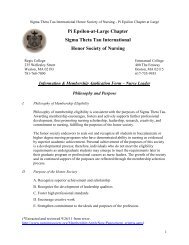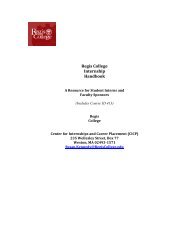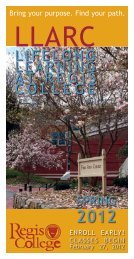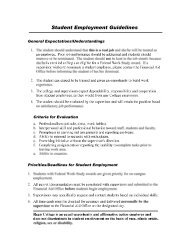Lucia Ortiz celebrates the African influence on Latin ... - Regis College
Lucia Ortiz celebrates the African influence on Latin ... - Regis College
Lucia Ortiz celebrates the African influence on Latin ... - Regis College
- No tags were found...
You also want an ePaper? Increase the reach of your titles
YUMPU automatically turns print PDFs into web optimized ePapers that Google loves.
12REGIS<str<strong>on</strong>g>Lucia</str<strong>on</strong>g> <str<strong>on</strong>g>Ortiz</str<strong>on</strong>g><str<strong>on</strong>g>celebrates</str<strong>on</strong>g> <str<strong>on</strong>g>the</str<strong>on</strong>g><str<strong>on</strong>g>African</str<strong>on</strong>g> <str<strong>on</strong>g>influence</str<strong>on</strong>g><strong>on</strong> <strong>Latin</strong> AmericaKathleen Dooher
Growing up in Colombia, Spanish professor <str<strong>on</strong>g>Lucia</str<strong>on</strong>g> <str<strong>on</strong>g>Ortiz</str<strong>on</strong>g>was completely unaware of <str<strong>on</strong>g>the</str<strong>on</strong>g> “invisible” populati<strong>on</strong>who c<strong>on</strong>tributed so much to her country’s lush identity andculture. Then she discovered Changó, <str<strong>on</strong>g>the</str<strong>on</strong>g> Biggest Badass.The historical novel by Afro-Colombian author ManuelZapata Olivella, published in 1983 and widely c<strong>on</strong>sidered tobe a masterpiece, tells <str<strong>on</strong>g>the</str<strong>on</strong>g> story of <str<strong>on</strong>g>the</str<strong>on</strong>g> <str<strong>on</strong>g>African</str<strong>on</strong>g> diaspora in<str<strong>on</strong>g>the</str<strong>on</strong>g> Americas over a period of five centuries, from <str<strong>on</strong>g>the</str<strong>on</strong>g> slavetrade in western Africa through <str<strong>on</strong>g>the</str<strong>on</strong>g> civil rights movementin <str<strong>on</strong>g>the</str<strong>on</strong>g> United States, with special attenti<strong>on</strong> to its impact <strong>on</strong><strong>Latin</strong> America.13SPRING 11By Kim Asch<str<strong>on</strong>g>Ortiz</str<strong>on</strong>g> was at Bost<strong>on</strong> University, working <strong>on</strong> her dissertati<strong>on</strong> about Colombian historyas seen through late 20th-century literature, when she first read <str<strong>on</strong>g>the</str<strong>on</strong>g> 500-pageepic. She learned about her country’s age-old mistreatment of Afro-Colombians, <str<strong>on</strong>g>the</str<strong>on</strong>g>blacks whose ancestors were brought as slaves in <str<strong>on</strong>g>the</str<strong>on</strong>g> 1700s to work <str<strong>on</strong>g>the</str<strong>on</strong>g> mines or in<str<strong>on</strong>g>the</str<strong>on</strong>g> sugarcane fields. And she realized just how much of her country’s customs, foods,and traditi<strong>on</strong>s are <str<strong>on</strong>g>influence</str<strong>on</strong>g>d by <str<strong>on</strong>g>African</str<strong>on</strong>g>, as well as indigenous and Spanish, cultures.“The author c<strong>on</strong>cludes that all <strong>Latin</strong> Americans are a ‘hybrid’ being, part indigenous,part Spanish, part <str<strong>on</strong>g>African</str<strong>on</strong>g>,” says <str<strong>on</strong>g>Ortiz</str<strong>on</strong>g>. “I was just fascinated by it. It was notanything I learned in school.”Because so much of <str<strong>on</strong>g>African</str<strong>on</strong>g> culture has melded with Colombian culture, <str<strong>on</strong>g>the</str<strong>on</strong>g> pervadingview is that Colombia is integrated and discriminati<strong>on</strong> does not exist, <str<strong>on</strong>g>Ortiz</str<strong>on</strong>g>explains. In fact, she says, Afro-descendents of Colombian society have been “madeinvisible.” For example, Cumbia music, now c<strong>on</strong>sidered representative of <str<strong>on</strong>g>the</str<strong>on</strong>g> country,started as a courtship dance am<strong>on</strong>g <str<strong>on</strong>g>the</str<strong>on</strong>g> slave populati<strong>on</strong> living al<strong>on</strong>g easternColombia’s Caribbean coast. The distinctive <str<strong>on</strong>g>African</str<strong>on</strong>g> drumbeats later mixed withstrains of Spanish guitar and <str<strong>on</strong>g>the</str<strong>on</strong>g> melodic pipes of indigenous pre-Colombians andbecame a truly multicultural art form. “People think, ‘We dance Cumbia. We’re notracist,’ ” <str<strong>on</strong>g>Ortiz</str<strong>on</strong>g> says. “But it’s not true; you see racism at all levels. The degrees of skinpigmentati<strong>on</strong> were always very important, and are still very important.”
14REGIS TODAYRural Afro-Colombian communities al<strong>on</strong>g <str<strong>on</strong>g>the</str<strong>on</strong>g>Pacific and Caribbean coasts c<strong>on</strong>tinue to face “pervasive,systemic discriminati<strong>on</strong>” despite sweepinglegislati<strong>on</strong> adopted in 1993 aimed at protecting <str<strong>on</strong>g>the</str<strong>on</strong>g>irterritorial rights, according to a report issued by <str<strong>on</strong>g>the</str<strong>on</strong>g>Rapoport Center for Human Rights and Justice at <str<strong>on</strong>g>the</str<strong>on</strong>g>University of Texas at Austin School of Law.<str<strong>on</strong>g>Ortiz</str<strong>on</strong>g> was determined to shine a light <strong>on</strong> this important,if uncomfortable, aspect of her country’s identity—throughnovels, poetry, and oral history. Sheincluded a chapter <strong>on</strong> Changó in her first book, and<str<strong>on</strong>g>the</str<strong>on</strong>g>n assembled and edited a collecti<strong>on</strong> of scholarlyarticles about little-known works of Afro-Colombianliterature that was published in Spanish in 2007 withher lengthy introducti<strong>on</strong>. It was an academic success,but <str<strong>on</strong>g>the</str<strong>on</strong>g> kind of expensive tome that might reach <strong>on</strong>lyhighly educated audiences. <str<strong>on</strong>g>Ortiz</str<strong>on</strong>g> remembers marvelingwith her collaborators: “Here we are writing aboutpeople who aren’t privileged and who face so manyissues every day, yet o<str<strong>on</strong>g>the</str<strong>on</strong>g>r people can’t learn about<str<strong>on</strong>g>the</str<strong>on</strong>g>m because <str<strong>on</strong>g>the</str<strong>on</strong>g> books are so expensive. What arewe doing writing <strong>on</strong>ly to each o<str<strong>on</strong>g>the</str<strong>on</strong>g>r?”Her latest book, due out this summer, is both acommiserati<strong>on</strong> and a celebrati<strong>on</strong> of <str<strong>on</strong>g>the</str<strong>on</strong>g> challengesand triumphs experienced by women of <str<strong>on</strong>g>African</str<strong>on</strong>g>descent from all over <strong>Latin</strong> America. Daughters of<str<strong>on</strong>g>the</str<strong>on</strong>g> Muntu: Critical Biographies of Afro-DescendentWomen from <strong>Latin</strong> America, coedited by <str<strong>on</strong>g>Ortiz</str<strong>on</strong>g> andMaria M. Jaramillo, comprises 34 articles and essaysand will be published in Spanish by a commercialhouse in Bogotá. The English translati<strong>on</strong> is expectedso<strong>on</strong> after.far away as possible,” she says. Many peers choosingto study abroad settled <strong>on</strong> <str<strong>on</strong>g>the</str<strong>on</strong>g> more familiar Miamiarea, but <str<strong>on</strong>g>Ortiz</str<strong>on</strong>g> was drawn to upstate New Yorkbecause she thought its proximity to Canada mightoffer <str<strong>on</strong>g>the</str<strong>on</strong>g> chance to explore yet ano<str<strong>on</strong>g>the</str<strong>on</strong>g>r country. Toher delight, she discovered a richly diverse internati<strong>on</strong>alcommunity right <strong>on</strong> campus and befriendedSaudis and <str<strong>on</strong>g>African</str<strong>on</strong>g>s and Europeans. “They camewith <str<strong>on</strong>g>the</str<strong>on</strong>g>ir costumes and <str<strong>on</strong>g>the</str<strong>on</strong>g>ir traditi<strong>on</strong>s, and we allshared <str<strong>on</strong>g>the</str<strong>on</strong>g> challenge of trying to communicate andadapt to a new culture toge<str<strong>on</strong>g>the</str<strong>on</strong>g>r.”While studying for a bachelor’s degree in internati<strong>on</strong>alrelati<strong>on</strong>s, she learned to view political andsocial systems with a critical eye. She also beganexamining her own culture through Spanish literaturecourses and gaining new insights about hercountry’s multicultural identity. She was loath toreturn to Colombia following graduati<strong>on</strong> in 1984because, she says, “I knew I wouldn’t have <str<strong>on</strong>g>the</str<strong>on</strong>g> independence,or <str<strong>on</strong>g>the</str<strong>on</strong>g> freedom I was able to gain, to pursue<str<strong>on</strong>g>the</str<strong>on</strong>g> future I could have here.” So she stayed <strong>on</strong>at Syracuse and earned a master’s degree in Spanishlanguage, literature, and culture before moving <strong>on</strong> to<str<strong>on</strong>g>the</str<strong>on</strong>g> PhD program at Bost<strong>on</strong> University. “Sometimesit was hard to be away from home, to be al<strong>on</strong>e,” shesays. “But I took every opportunity that came al<strong>on</strong>g.”At <strong>Regis</strong>, <str<strong>on</strong>g>Ortiz</str<strong>on</strong>g> is <str<strong>on</strong>g>the</str<strong>on</strong>g> adviser for <str<strong>on</strong>g>the</str<strong>on</strong>g> <strong>Latin</strong>American Student Associati<strong>on</strong> and serves as “a rolemodel of a successful immigrant, which is extremelyimportant” for <str<strong>on</strong>g>the</str<strong>on</strong>g> <strong>College</strong>’s vibrant community offirst-generati<strong>on</strong> Americans, says Spanish departmentcolleague Mary-Anne Vetterling. She lists her“You see racism at all levels. The degrees of skin pigmentati<strong>on</strong>were always very important, and are still very important.”“With this book, we were able to get closer to<str<strong>on</strong>g>the</str<strong>on</strong>g> people,” says <str<strong>on</strong>g>Ortiz</str<strong>on</strong>g>, who traveled to Colombia,Mexico, and Puerto Rico to c<strong>on</strong>duct her research.“Through <str<strong>on</strong>g>the</str<strong>on</strong>g> process of ga<str<strong>on</strong>g>the</str<strong>on</strong>g>ring <str<strong>on</strong>g>the</str<strong>on</strong>g>ir stories, Ilearned so much about <str<strong>on</strong>g>the</str<strong>on</strong>g> impact of <str<strong>on</strong>g>the</str<strong>on</strong>g>se women<strong>on</strong> <strong>Latin</strong> American culture.”<str<strong>on</strong>g>Ortiz</str<strong>on</strong>g> counts herself lucky to have been raisedby forward-thinking Colombian parents who wanted<str<strong>on</strong>g>the</str<strong>on</strong>g>ir two daughters to go far in <str<strong>on</strong>g>the</str<strong>on</strong>g>ir educati<strong>on</strong>.At 18, she lobbied <str<strong>on</strong>g>the</str<strong>on</strong>g>m to send her to <str<strong>on</strong>g>the</str<strong>on</strong>g> UnitedStates to study English; she was supposed to beg<strong>on</strong>e <strong>on</strong>ly <strong>on</strong>e year, but instead enrolled at SyracuseUniversity and never returned to her native countryfor l<strong>on</strong>ger than a visit.“I grew up in a very small town, with all <str<strong>on</strong>g>the</str<strong>on</strong>g> issuesyou face as a young woman in a small, c<strong>on</strong>servative,Catholic town. I was eager to leave, to get asgood friend’s accomplishments: <str<strong>on</strong>g>Ortiz</str<strong>on</strong>g> is a full professor,having received that title at a fairly young agein her career, and serves as department chair; shehas become an American citizen; she’s received <str<strong>on</strong>g>the</str<strong>on</strong>g>prestigious Virginia Kaneb Faculty Scholars Grantnot just <strong>on</strong>ce, but three times, to support expensesassociated with researching her books.Known for her intellectual rigor and <str<strong>on</strong>g>the</str<strong>on</strong>g> high standardsshe sets for both herself and her students, <str<strong>on</strong>g>Ortiz</str<strong>on</strong>g>can often be overheard around <str<strong>on</strong>g>the</str<strong>on</strong>g> Spanish departmentassessing, with certain zeal, <str<strong>on</strong>g>the</str<strong>on</strong>g> m<strong>on</strong>t<strong>on</strong>ón detrabajo, or huge mountain of work, awaiting her.<str<strong>on</strong>g>Ortiz</str<strong>on</strong>g>’s work <strong>on</strong> <str<strong>on</strong>g>the</str<strong>on</strong>g> forefr<strong>on</strong>t of <str<strong>on</strong>g>the</str<strong>on</strong>g> emergingfield of Afro-Colombian literature, and <str<strong>on</strong>g>the</str<strong>on</strong>g> stillnarrower field of Afro-<strong>Latin</strong>a literature, is wellrecognized, and she was even invited to a recepti<strong>on</strong>with Colombia’s president.
















